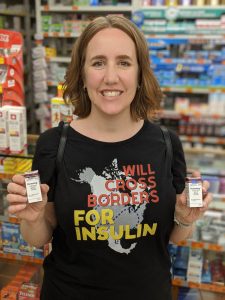My name is Lija Greenseid, and I’m one of the thousands of parents whose children live with type 1 diabetes in the United States. When my daughter was first diagnosed, I was shocked –– first by the diagnosis itself and then by the economic cost that came with it. My daughter takes insulin, a drug that has increased by over 1000% in price over the past decade. We hit our insurance out-of-pocket limit for the year with just the first visit to the pharmacy to pick up my daughter’s diabetes medications and supplies.
A few years after my daughter was diagnosed, I heard Nicole Smith-Holt talk about losing her son, Alec, after he rationed his insulin because of the price. I knew then that I needed to get involved. Nicole’s story was similar to other people’s stories, and I worried it could be mine too if someday my daughter couldn’t afford or access her insulin.

Four years ago, my family and I traveled around the world and bought insulin at one-tenth or less the price we paid at home. I grew frustrated thinking of all the families like mine who were paying unreasonably high prices for our insulin, and especially of the families like Nicole’s who had lost loved ones because of the price gouging on insulin. The United States is unique, in a bad way, in how expensive insulin is here. Other countries pay a fraction of what we pay for our insulin. I started sharing my story and took an active role in the fight for affordable insulin.
Though I work part-time as a program evaluator, I began spending more and more of my time advocating for affordable drugs and health care changes. Living in Minnesota, just five hours from Canada, I and several other people with diabetes organized a cross-border trip to raise awareness of the unaffordability of insulin and to purchase the drug at one-tenth of the US price. There have been multiple of these “Caravans to Canada” trips and they have gained national media attention, pressuring elected officials and drug companies to acknowledge the unreasonable price gouging on insulin. Additionally, it brought attention to the thousands of people every year who travel to other countries just to afford their life-saving medications.
When it comes to cheaper insulin prices, Canada isn’t an outlier. Their prices could be our prices here in the United States. If our lawmakers allowed Medicare to negotiate with drug manufacturers as the Canadian public insurance does, the price would decrease significantly. We need lawmakers with the courage to prioritize patients and work to decrease the cost of prescription drugs like insulin.
Because of our advocacy in Minnesota, some insurers in our state have capped their prices, allowing some people to only pay $25-30 a month for insulin. Additionally, we passed the Alec Smith Insulin Affordability Act which provides a safety net for Minnesotans who can’t afford their insulin. But this is not enough. Insulin is just one drug. We need solutions both at the state and national levels to address the system-wide greed of drug companies. Drug companies continue to charge ridiculous prices, further exacerbating already existing racial and economic inequities in our health care and prescription drug systems. High prices disproportionately affect black and brown communities, the same people hit hardest by the COVID-19 pandemic. In such a critical moment in our country, I’m inspired to refocus my activism and continue advocating for a more just system.
